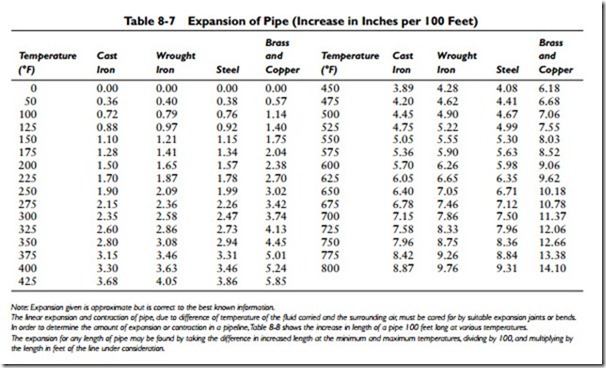Reducing or Enlarging Fittings
Both bushings and reducers are examples of reducing or enlarging fittings. Their function in pipe installations is to connect pipes of different sizes.
Bushings and reducers may be distinguished by their construction. A reducer is a coupling device with female threads at both ends (see Figure 8-3). A bushing has both male and female threads.
A bushing (see Figure 8-3) is a pipe fitting designed in the form of a hollow plug, and it is used to connect the male thread of a pipe end to a fitting of larger size. Bushings are sold according to the pipe size of the male thread. Thus, a 1⁄4-inch bushing (or, more specifically, a
The expansion for any length of pipe may be found by taking the difference in increased length at the minimum and maximum temperatures, dividing by 100, and multiplying by the length in feet of the line under consideration.
1⁄4-inchX1⁄8-inch bushing) is one used to connect a 1⁄4-inch fitting to a 1⁄8-inch pipe. This may be less confusing if you remember that a bush- ing has one male and one female thread and that the female thread of the bushing must be tightened into the male thread of the pipe end.
Ordinary bushings are sometimes used when a reducing fitting of proper size is unavailable. If the reduction is considerable, it may be necessary to use two bushings. A common application of eccentric bushings is to avoid water pockets on horizontal pipelines. This application is illustrated in Eliminating Water Pockets later in the chapter.
Directional Fittings
Directional fittings such as offsets, elbows, and return bends are used to change the direction of a pipe. Because of an overlap in function, offsets also may be considered to be a type of extension or joining fitting.
Elbows
An elbow (see Figure 8-3) is a pipe fitting used to change the direction of a gas, water, or steam pipeline. Elbows are available in stan- dard angles of 45° and 90,° or special angles of 22 1⁄2° and 60° (see Figure 8-3).
Return Bends
A return bend (see Figure 8-3) is a U-shaped pipe fitting commonly used for making up pipe coils for both water and steam heating boilers. They are commonly available in three patterns (close, medium, and open) with female threads at both ends. It is important to know the dimensions between centers when making up heating coils in order to avoid possible interference.
Branching Fittings
As the name implies, a branching fitting is used to join a branch pipe to the main pipeline. The principal branching fittings used for this purpose are as follows:
• Tees
• Crosses
• Y branches
• Elbows with side outlets
• Return bends with back or side outlets
Tees
Tees (see Figure 8-3) are made in a variety of sizes and patterns and represent the most widely used branch fitting. As the name suggests, a tee fitting is used for starting a branch pipe at a 90° angle to the main pipe.
A tee fitting is specified by first giving the run and then the branch. The run of a tee refers to its body with the outlets opposite each other (that is, at 180).
Tees are available with all three outlets the same size, with the branch outlet a size different from the two outlets of the run, or with all three outlets different sizes. Whatever the size configuration of outlets, the run is always specified first. Tee specifications generally take the following form:
• 1″ (1-inch outlets on run and tee)
• 1″X 1⁄2″ (1-inch outlets on run; 1⁄2-inch tee outlet)
• 1″ X 1⁄2″ (outlets of 1 inch and 1⁄2 inch on the run; 1⁄2-inch tee outlet)
Crosses
A cross fitting (see Figure 8-3) is simply a tee with two branch outlets instead of one. The branch outlets are located directly opposite one another on the main pipe so that the fitting forms the shape of a cross (hence its name). Both branch outlets are always the same size, regardless of the size of the outlets.
Branches
A Y branch (see Figure 8-3) is a pipe fitting with side outlets located at 45° or 60° angles to the main pipe. Y branches are available in a number of pipe sizes. They may be straight or reducing, and single- or double-branching.
Elbows with Side Outlets
An elbow with three outlets is classified as a branching rather than a directional fitting because the third outlet serves as the connection for a branch pipeline (see Figure 8-3). The branching outlet should be at a 90° angle to the plane of the elbow run.
Return Bends with Back or Side Outlets
An ordinary return bend is a U-shaped fitting with two outlets (see
Figure 8-3). Some return bends are designed with three outlets, the third outlet being located on either the back or the side of the fitting and used for connecting to a branch pipeline. This type of return bend is more properly classified as a branching fitting.
Shutoff or Closing Fittings
Sometimes it is necessary to close the end of a fitting or pipe. This is accomplished with a shutoff or closing fitting, and the following two types are used for this purpose:
• Plugs
• Caps
Plugs
A plug (see Figure 8-3) is used to close the end of a pipe or fitting when it has a female thread. In other words, it is designed to be inserted into the end of the pipe or fitting. Plugs are made in a vari- ety of sizes (1⁄8 inch to 12 inches), designs (hexagon, square head, or countersunk heads), and materials (for example, iron, brass).
Caps
A cap (see Figure 8-3) performs the same function as a plug except that it is used to close the end of a pipe or fitting that has a male thread. They are also available in a variety of sizes, designs, and materials.
